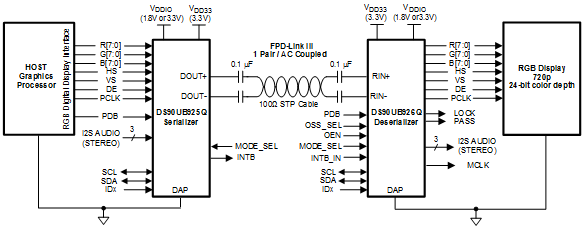SNLS422D July 2012 – August 2017 DS90UB926Q-Q1
PRODUCTION DATA.
- 1 Features
- 2 Applications
- 3 Description
- 4 Revision History
- 5 Description (continued)
- 6 Pin Configuration and Functions
-
7 Specifications
- 7.1 Absolute Maximum Ratings
- 7.2 ESD Ratings
- 7.3 Recommended Operating Conditions
- 7.4 Thermal Information
- 7.5 DC Electrical Characteristics
- 7.6 AC Electrical Characteristics
- 7.7 DC and AC Serial Control Bus Characteristics
- 7.8 Timing Requirements
- 7.9 Timing Requirements for the Serial Control Bus
- 7.10 Switching Characteristics
- 7.11 Timing Diagrams
- 7.12 Typical Characteristics
-
8 Detailed Description
- 8.1 Overview
- 8.2 Functional Block Diagram
- 8.3
Feature Description
- 8.3.1 High-Speed Forward Channel Data Transfer
- 8.3.2 Low-Speed Back Channel Data Transfer
- 8.3.3 Backward-Compatible Mode
- 8.3.4 Input Equalization Gain
- 8.3.5 Common-Mode Filter Pin (CMF)
- 8.3.6 Video Control Signal Filter
- 8.3.7 EMI Reduction Features
- 8.3.8 Enhanced Progressive Turnon (EPTO)
- 8.3.9 LVCMOS VDDIO Option
- 8.3.10 Power Down (PDB)
- 8.3.11 Stop Stream Sleep
- 8.3.12 Serial Link Fault Detect
- 8.3.13 Oscillator Output
- 8.3.14 Pixel Clock Edge Select (RFB)
- 8.3.15 Image Enhancement Features
- 8.3.16 Internal Pattern Generation
- 8.3.17 Built-In Self Test (BIST)
- 8.3.18 I2S Receiving
- 8.3.19 Interrupt Pin — Functional Description and Usage (INTB)
- 8.3.20 GPIO[3:0] and GPO_REG[8:4]
- 8.4 Device Functional Modes
- 8.5 Programming
- 8.6 Register Maps
- 9 Application and Implementation
- 10Power Supply Recommendations
- 11Layout
- 12Device and Documentation Support
- 13Mechanical, Packaging, and Orderable Information
1 Features
- AEC-Q100 Qualified for Automotive Applications
- Device Temperature Grade 2: –40°C to +105°C Ambient Operating Temperature
- Device HBM ESD Classification Level 3B
- Device CDM ESD Classification Level C6
- Device MM ESD Classification Level M3
- Bidirectional Control Interface Channel Interface With I2C-Compatible Serial Control Bus
- Supports High-Definition (720p) Digital Video Format
- RGB888 + VS, HS, DE and Synchronized I2S Audio Supported
- 5- to 85-MHz PCLK Supported
- Single 3.3-V Operation With 1.8-V or 3.3-V Compatible LVCMOS I/O Interface
- AC-Coupled STP Interconnect up to 10 Meters
- Parallel LVCMOS Video Outputs
- I2C-Compatible Serial Control Bus for Configuration
- DC-Balanced and Scrambled Data With Embedded Clock
- Adaptive Cable Equalization
- Supports Repeater Application
- @ SPEED Link BIST Mode and LOCK Status Pin
- Image Enhancement (White Balance and Dithering) and Internal Pattern Generation
- EMI Minimization (SSCG and EPTO)
- Low Power Modes Minimize Power Dissipation
- Backward-Compatible With FPD-Link II
2 Applications
- Automotive Display for Navigation
- Rear Seat Entertainment Systems
- Automotive Drive Assistance
- Automotive Megapixel Camera Systems
3 Description
The DS90UB926Q-Q1 deserializer, in conjunction with the DS90UB925Q-Q1 serializer, provides a complete digital interface for concurrent transmission of high-speed video, audio, and control data for automotive display and image-sensing applications.
This chipset translates a parallel RGB video interface into a single-pair high-speed serialized interface. The serial bus scheme, FPD-Link III, supports full duplex of high-speed forward data transmission and low-speed backchannel communication over a single differential link. Consolidation of video data and control over a single differential pair reduces the interconnect size and weight, while also eliminating skew issues and simplifying system design.
The DS90UB926Q-Q1 deserializer recovers the RGB data, three video control signals, and four synchronized I2S audio signals. The device extracts the clock from a high-speed serial stream. An output LOCK pin provides the link status if the incoming data stream is locked, without the use of a training sequence or special SYNC patterns, as well as a reference clock.
Device Information(1)
| PART NUMBER | PACKAGE | BODY SIZE (NOM) |
|---|---|---|
| DS90UB926Q-Q1 | WQFN (60) | 9.00 mm × 9.00 mm |
- For all available packages, see the orderable addendum at the end of the data sheet.
Typical Display System Diagram
